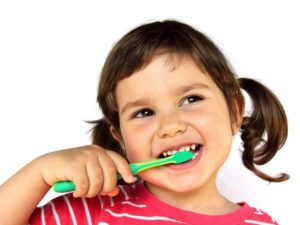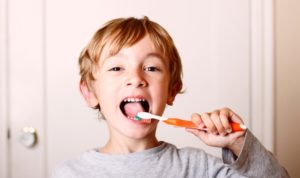Healthy Habits for Happy Teeth!
Even if your child is only an infant or toddler, you can start now to help your child develop strong, healthy teeth and build habits that last a lifetime.
-
- Begin cleaning your infant’s teeth as soon as the first tooth appears. Use a damp cloth to swab clean.
- When more teeth emerge, use a small, soft-bristled brush and water only. Around age 2 or 3 add a pea-sized amount of fluoride toothpaste to brush.
- As your child gains hand and finger control, encourage him to brush his own teeth. Supervise until around the age of 7 or 8.
- Encourage your child to spit out the toothpaste, not swallow. Fluoride fights decay, but if too much is swallowed, permanent teeth may develop white spots.
- Teach your child to brush after breakfast and before bedtime. Explain that germs in the mouth attack traces of food left on teeth and make cavities.
- Set an example. Children will be more likely to adopt brushing as a habit if they see you brushing. Use vertical, not horizontal, motion.
- Provide a healthy diet that emphasizes fruits, whole grains, vegetables, milk products, meats, and eggs.
- Cut out sugary and starchy snacks. Instead of offering chips and cookies, encourage fruits, veggies and cheese. Offer water instead of fruit drinks.
- Put your baby to bed without a bottle. Liquid pools in the front of the mouth and bacteria changes the liquid sugars into acid, which then eats away at teeth.
Teething
Although newborns usually have no visible teeth, most baby teeth begin to appear about six months after birth. During the first few years of your child’s life, all 20 baby teeth emerge and most children will have their full set of these teeth in place by age 3. A baby’s front four teeth usually emerge at about six months of age, although some children don’t have their first tooth until 12 or 14 months. As their teeth erupt, some babies may become fussy, sleepless and irritable, lose their appetite or drool more than usual. Teething Rings may provide some relief for your child.

- First Dental Visit When your child’s first tooth appears, it’s time to schedule the first dental visit. The ADA recommends that this first dental visit take place within six months after the first tooth appears, but no later than a child’s first birthday. It is important to start early and allow your child to become familiar with dental visits and healthy habits!
Typically, the first visit to the dentist is to allow the dentist to examine your child’s mouth and to check growth and development as well as to help your child become comfortable with the overall experience.
Here are some helpful tips to make the visit positive:
- Keep any anxiety or concerns you have to yourself, children can often pick up on your emotions, so remain positive!
- Make an appointment when you child will be most cooperative.
- Talk with your child about visiting the dentist and what to expect.
During this initial visit, you can expect:
- Inspect the overall oral healthy, check for cavities or other problems.
- Clean your child’s teeth and provide tips for daily care.
- Discuss questions you may have about teething, pacifier use, or finger/thumb sucking habits.
- Let you know if your child is at risk of developing tooth decay
- Discuss any necessary treatment, if needed, and schedule the next check-up.
American Dental Association (2015). “First Dental Visit” ” Retrieved from: http://www.ada.org/~/media/ADA/Publications/Files/ADA_PatientSmart_First_Dental_Visit.ashx